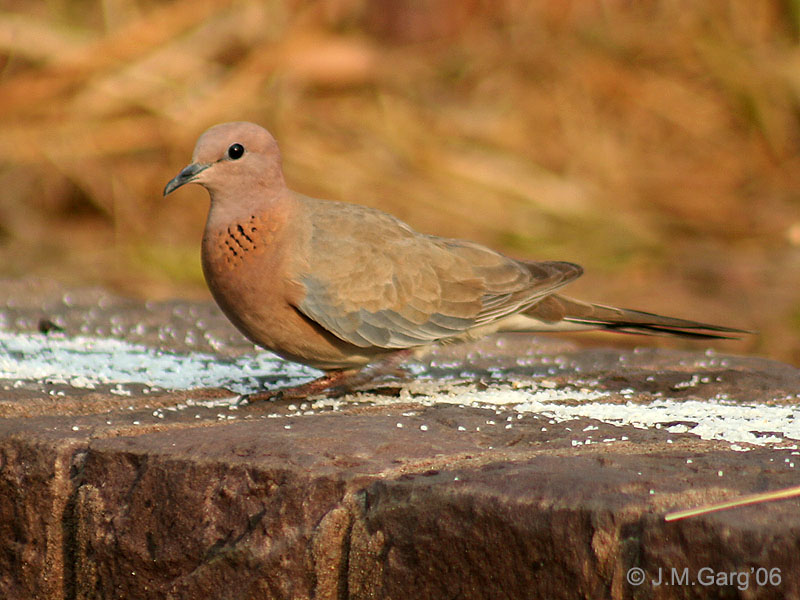|
| Query: spotted turtle dove | Result: 8th of 12 | |
Genus Streptopelia (Family: Columbidae, Doves) - Wiki
| Subject: | Genus Streptopelia (Family: Columbidae, Doves) - Wiki
| |

| Resolution: 800x600
File Size: 129591 Bytes
Date: 2006:03:03 07:51:53
Camera: Canon EOS 350D DIGITAL (Canon)
F number: f/5.6
Exposure: 1/125 sec
Focal Length: 300/1
Upload Date: 2007:10:30 16:07:43
|
Streptopelia
From Wikipedia, the free encyclopedia
[Photo] Laughing Dove (Streptopelia senegalensis) in Bhopal, Madhya Pradesh, India. Date 3.03.06. Author J.M.Garg (http://commons.wikimedia.org/wiki/User:J.M.Garg) Copyright (C) 2006 J. M. Garg
Permission is granted to copy, distribute and/or modify this document under the terms of the GNU Free Documentation License, Version 1.2 or any later version published by the Free Software Foundation; with no Invariant Sections, no Front-Cover Texts, and no Back-Cover Texts. A copy of the license is included in the section entitled "GNU Free Documentation License". |
Streptopelia is a genus of birds in the dove family. These are mainly slim, small to medium-sized species. The upperparts tend to be pale brown, and the underparts are often a shade of pink. Many have a characteristic black-and-white patch on the neck, and monotonous cooing songs.
The heartland of this genus is Africa, but several species occur in tropical southern Asia. As a group, this genus is highly successful; many species are abundant in a range of habitats in the tropics, and two now have a much more extensive distribution.
The Eurasian Collared Dove, Streptopelia decaocto, naturally expanded out of its original range of the warmer temperate regions from south east Europe to Japan to colonise the rest of Europe, reaching as far west as Great Britain by 1960, and Ireland soon after. It has also been introduced into the USA and, as of 1999 it had been reported from 22 states and was still spreading rapidly.
The Spotted Dove, Streptopelia chinensis, is an abundant and ubiquitous resident breeding bird in tropical southern Asia, but it has been introduced to the U.S., Hawaii, northern Indonesia, Australia and New Zealand.
A recent DNA sequence analysis (Johnson et al., 2001) has concluded that the genus consists of three distinct lineages. One contains the Laughing Dove and the Spotted Dove, which have long been recognized as having distinct morphology and behavior. The second group contains most of the other species, except the Madagascar Turtle Dove and the Pink Pigeon, which appear to be the surviving species of an endemic Madagascar/Mascarenes radiation and have at times been placed in other genera. The two-species lineages appear to be each other's closest relatives and cannot be firmly assigned to either Columba or Streptopelia (although overall they seem to be close to the latter). Thus, it might be best to split the two minor lineages off as distinct genera, namely Stigmatopelia for the first and Nesoenas for the last.
Species
Possibly separable as Stigmatopelia
Laughing Dove Streptopelia senegalensis
Spotted Dove Streptopelia chinensis
Streptopelia main lineage
Eurasian Collared Dove or simply Collared Dove, Streptopelia decaocto
Barbary Dove Streptopelia risoria (domesticated; taxonomic status doubtful)
African Collared Dove, Streptopelia roseogrisea
Turtle Dove Streptopelia turtur
Oriental Turtle Dove Streptopelia orientalis
Dusky Turtle Dove, Streptopelia lugens
Adamawa Turtle Dove, Streptopelia hypopyrrha
Island Collared Dove, Streptopelia bitorquata
White-winged Collared Dove, Streptopelia reichenowi
African Mourning Dove, Streptopelia decipiens
Red-eyed Dove, Streptopelia semitorquata
Ring-necked Dove, Streptopelia capicola
Vinaceous Dove, Streptopelia vinacea
Red Turtle Dove, Streptopelia tranquebarica
Possibly separable as Nesoenas
Madagascar Turtle Dove, Streptopelia picturata
- Rodrigues Turtle Dove, Streptopelia (picturata) rodericana - extinct (before 1690?)
Pink Pigeon, Streptopelia mayeri
R??union Pink Pigeon, Streptopelia duboisi - extinct (c.1700)
http://en.wikipedia.org/wiki/Streptopelia
| The text in this page is based on the copyrighted Wikipedia article shown in above URL. It is used under the GNU Free Documentation License. You may redistribute it, verbatim or modified, providing that you comply with the terms of the GFDL. |
|
^o^
Animal Pictures Archive for smart phones
^o^
|
|

